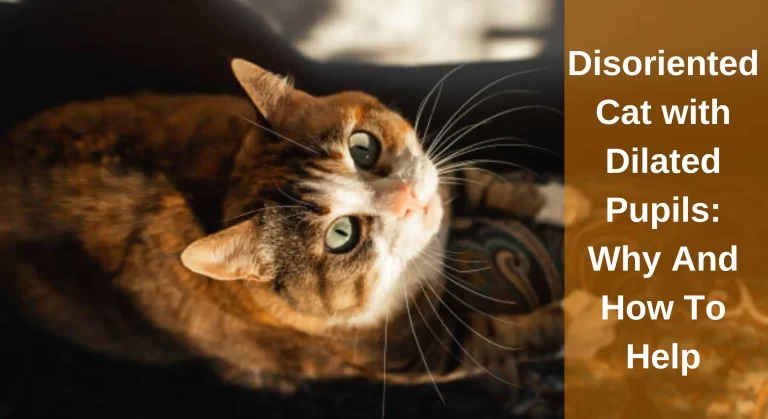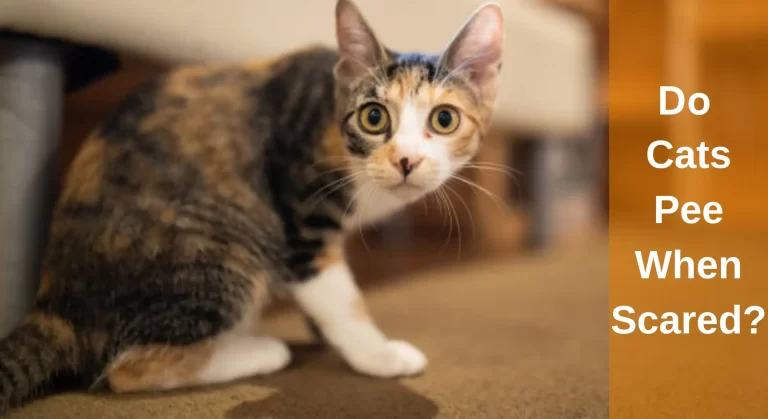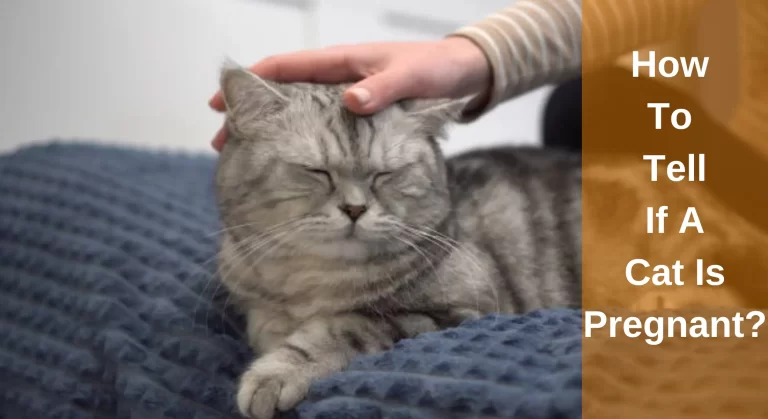Why Is My Cat So Scared of Everything – How to Comphy My Scared Cat?
If you’re a cat owner, you may have noticed that the slightest noise or sudden movement easily spooks your feline friend. This is not uncommon, as cats are known to be easily frightened.
If your cat’s behaviour changes suddenly or hiding or escaping, it means your cat is not comfortable; there’s definitely a fear-based cause.
If your cat suddenly becomes terrified of everything, look at whether anything has changed in its living environment. Cats can become nervous when their routine is disrupted, such as by moving furniture or having different people around. A cat may feel vulnerable when disturbed by loud noises, predatory animals, pets, illness, or injury.
In this article, we will explain why cats can be scared of everything and provide some tips on how to help your cat feel more comfortable and secure in their environment.

Reasons Why Is My Cat So Scared of Everything
Before we dive into ways to help your cat feel less scared, it’s important to understand their behaviour. Cats are highly independent creatures and can become easily stressed when their routine is disrupted, or their environment is changed.
A calm and composed owner is required to handle the needs of a terrified cat. They communicate through body language, vocalizations, and scent marking. Understanding your cat’s behaviour can help you identify signs of fear or anxiety and take steps to alleviate their distress.
1. Former Trauma
Harassment and trauma can have a negative impact on a cat’s mental health. Cats that have experienced trauma or abuse may be more likely to be fearful of people, other animals, and new environments.
If you got a cat from a shelter, especially if it was an older cat, you might not be aware of its past. Sadly, there are a number of cats in shelters who have been abandoned, mistreated, or neglected. This may cause your cat to become fearful of everything since they have never had a safe place to call home.
If your cat has a history of trauma or abuse, it may take time and patience to help them feel comfortable and secure.
2. New Surroundings
Cats are descendants of wild animals, and their genetics have not changed significantly over the centuries. Their natural instincts include being wary of unfamiliar situations and avoiding danger. This instinct is why your cat may be scared of everything from a new toy to a strange sound.
One of the biggest transitions a cat will ever go through is moving homes. When you’re driving, your cat can meow excessively, pant a lot, and shed a lot of furs. When you get to your location, your cat will definitely be in a very different environment definitely.
3. Separation Phobia
Cats need companionship even though many people wrongly believe that they are aloof and independent creatures. If cats are left alone for long periods of time during the day, they may develop separation anxiety. They are concerned that you won’t return home at this moment because they are terrified of abandonment.
Separation anxiety can also affect cats that have been adopted after being abandoned by their original owners or kittens who their moms have abandoned.
4. Multi-felines Family
If your cat suddenly starts acting excessively anxious and jumpy after adopting a new cat, you may be quite positive that this is the cause. It’s probable that your cat is used to being home alone. Your older cat feels like its territory has been invaded when a new cat or kitten comes in.
The first time you bring a new kitten home, you might find that cats arch their backs and hiss at the new member of the family.
Cats also tend to suffer from depression after the newly adopted kitten is brought home. Your cat might hide more than usual and lose interest in activities she once enjoyed.
Cats aren’t the only creatures to feel uneasy around a new family member: dogs, turtles, and even newborns can cause discomfort. This causes them to be skittish and jumpy toward everything as they don’t know what they will do next.
Some cats don’t get along with other cats, dogs, or kids. It could be crucial to create a Kitty Zone away from kid-friendly play areas so you can monitor how your new, anxious cat behaves around little ones.
5. Lack of Socialization
Cats that are not properly socialized as kittens may be fearful of new experiences later in life. If your cat did not have the opportunity to interact with humans and other animals when they were young, they might not know how to behave in unfamiliar situations.
Although Kitty may have interacted with humans while living in a shelter, a stray cat may find it difficult to adapt to a lifelong relationship with a person.
Making them feel at ease and secure in this situation takes a lot of time and work, but it is possible.
Also, Check Out: Do Cats Pee When Scared Or Stressed?
6. Medical Issues (Illness & Injury)
Has your cat developed a severe dread of everything? But no major adjustments, like a move or a new pet, have been made? If so, there’s a chance your cat has a health problem of some kind.
In some cases, a cat’s fear may be related to an underlying medical issue. Due to their discomfort and suffering, they could get worried, and they might bite or attack you. Furthermore, sick cats are more exposed, which might make them tense.
If your cat is suddenly exhibiting fearful behaviour, it may be worth taking them to the veterinarian to rule out any medical problems.
Also Read: How Long Can You Leave a Cat Alone Safely?
How Do I Know My Cat is Scared? Common Signs
All cats, nevertheless, will behave differently if they are terrified. To confirm your cat’s sentiments, Here are some common signs to look out for that may indicate that your cat is nervous or afraid:
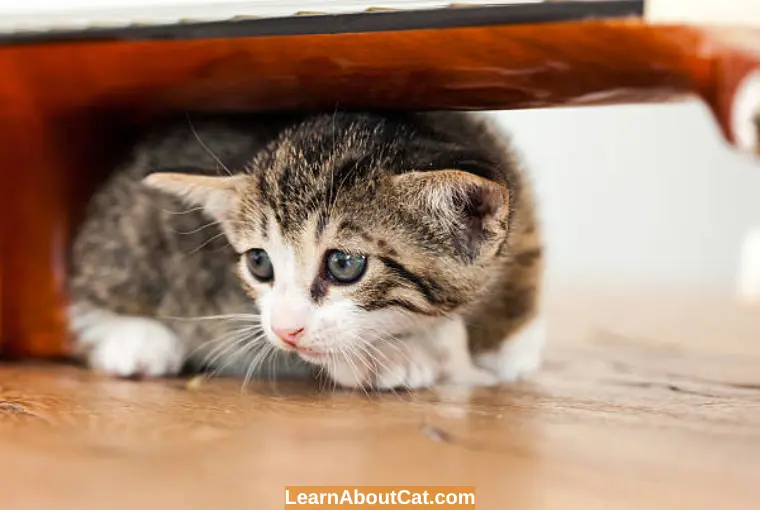
- Hiding behaviour: If your cat is hiding in a small, enclosed space, such as under a bed or in a closet, it may be a sign that they are feeling nervous or afraid. Fearful cats will hide more frequently than usual. They act this way to flee and escape whatever they perceive to be a threat.
- Changes in appetite: If your cat acts properly yet doesn’t eat much, it may be because they are anxious. But some cats overeat when they’re frightened.
- Strange voice: Cats in fear typically meow in a deep, continuous tone that is nearly growling. If your cat is hissing or growling, it may be a sign that they feel threatened or uncomfortable. Hissing in reaction to a perceived threat is another overt sign of anxiety.
- Dilated Pupils: A cat’s pupils will dilate in low light conditions, but they may also become dilated when the cat is feeling scared or nervous.
- Fearful body posture: Cats who are nervous tend to have flattened ears and open, wide-set eyes. Cats have arched backs and puffy tails when an immediate threat is apparent.
- Tail Position: A cat’s tail can be a good indicator of its mood. If their tail is tucked between their legs or is puffed up, it may be a sign that they are feeling nervous or afraid.
- Jumpy & skittish: A nervous cat will have a hard time ever calming down. You could tell that they paced a lot and had trouble sleeping. The tiniest sounds touch, or other environmental disruptions will also cause them to spring.
- Excessive self-grooming: Cats who are afraid of something may groom themselves excessively to the point where they might start balding. Cats will also nibble on their nails when under stress.
- Avoiding Eye Contact: Cats may avoid eye contact when they are feeling nervous or afraid, as it can be seen as a sign of aggression.
If you notice any of these behaviours in your cat, it’s important to try and identify the source of their anxiety and take steps to help them feel more comfortable and secure.
Providing a safe space, using calming aids, and gradually exposing them to new experiences can all be helpful in reducing their anxiety.
If you are concerned about your cat’s behaviour, it’s always a good idea to consult with a veterinarian or a professional animal behaviourist.
How Do I Find Out What is Frightening My Cat?
Finding out what is frightening your cat can be a process of elimination. Here are some steps you can take to help identify the source of their anxiety:
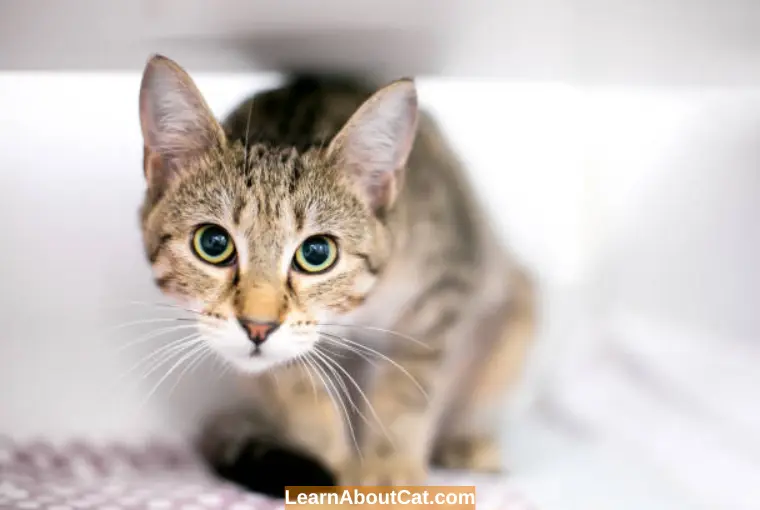
- Observe Your Cat’s Behavior – Pay attention to when your cat exhibits nervous or fearful behaviours. Note the time, location, and any possible triggers that may have caused the behaviour.
- Look for Patterns – If your cat is consistently scared or nervous in certain situations or around certain people or objects, it may be a sign that those are the triggers for their anxiety.
- Rule Out Medical Issues – It’s important to make sure that no underlying medical issues are causing your cat’s behaviour. Take your cat to the vet for a check-up to rule out any health issues that could be causing their anxiety.
Remember that identifying the source of your cat’s anxiety may take time and patience, but with the right approach, you can help them feel more comfortable and secure in their environment.
Also Read: Why My Cat is Hiding And Acting Weird?
How Do I Stop My Cat From Being Scared of Everything?
If your cat is frightened or anxious, there are several things you can do to help them feel more comfortable and secure:

1. Take it Easy, Relax, and Avoid being Hurried
Many cat owners try to reach their cat’s hiding location or remove it from a high perch. Never use force when dealing with your cat since it is hiding because it is anxious and needs space.
Be patient and let your cat come to you when the time is right. Pet them, converse affectionately with them, or play with them.
It takes time to assist timid cats in breaking their fear cycle. Use patience, and don’t push your cat into anything. That implies that you shouldn’t drag it about the home against its will or shoo it under the bed. Simply said, this will make individuals act more frightened.
3. Establish a Serene Environment
Creating a tranquil living space for your shy and anxious cat is the finest thing you can do for them. You should eliminate as many stress-causing elements from your surroundings as you can.
Here are some suggestions for creating a serene setting that invites cats:
- Provide your cat with several elevated perches so it may climb there for safety if required.
- Catnip-infused toys are a great way to get your cat to play with catnip if it responds well to it.
- Don’t create as much noise as possible, and try to avoid making any loud noises.
- Make certain your cat has specific retreats where it may hide.
- Do not invite more guests than your cat is familiar with.
- Don’t let visitors bring their pets or other animals into your home.
- Instead, give your cat a tonne of toys to keep them entertained and cognitively active.
4. Establish a Kitty Room
Due to their territorial nature, cats may find uncomfortably having a big area to supervise. The special area delivers all the comforts cats need and creates a home within a house with food, litter, a bed, and toys.
Cats feel most secure when they have a place to retreat to where they feel safe and comfortable. Provide your cat with a cosy hiding spot, such as a cat bed or a cardboard box, in a quiet room where they can relax.
5. Make Positive Associations
By creating a positive link with your cat’s triggers, you may try to train them and assist them in overcoming their anxieties.
Whenever your cat hides, encouraging positive interactions with them can also be beneficial. Play with your cat’s favourite toy on the other side of the room if you want to get your cat out of its hiding spot instead of removing them physically. Most cats can’t resist playing with their favourite toy.
Also, treats can be used to encourage shy cats to come out of hiding. However, make sure you don’t overdo it. Too many treats can lead to weight gain, which has numerous negative health consequences.
6. Create a Consistent Routine
Cats thrive on routine, so establishing a consistent feeding and playtime schedule can help them feel more secure and less anxious.
7. Gradual Exposure to New Experiences
If your cat is afraid of certain situations or objects, gradually exposing them to these things in a controlled and positive way can help them become more comfortable and less fearful.
8. Provide Enrichment Activities
Providing your cat with toys and activities that stimulate their natural instincts, such as hunting and play, can help reduce their anxiety and increase their confidence.
9. Use Calming Pheromones
There are a variety of products available, such as pheromone sprays or diffusers, that can help calm your cat and reduce their anxiety. Talk to your veterinarian about which products may be best for your cat.
10. Get Professional Guidance
If your cat’s anxiety is severe or you are having difficulty managing its fear, consider consulting with a veterinarian or professional animal behaviourist for help.
Your veterinarian will check to see if your cat has any underlying medical conditions that would be the source of their ongoing concern. The best treatment usually combines pharmacological therapy with behavioural therapy. They may also suggest anti-anxiety medications to lift your cat’s spirits.
Intresting Reading: Why is My Cat Afraid of Ceiling Fan?
Frequently Asked Questions
What makes cats feel afraid?
There are many things that can make cats feel afraid, including:
1. Loud Noises – Sudden noises such as thunderstorms, fireworks, or construction noises can be frightening for cats.
2. New Environments – Cats are territorial animals and may feel uncomfortable in new or unfamiliar environments.
3. New People or Animals – Introducing new people or animals into a cat’s home can be stressful and cause fear and anxiety.
5. Lack of Socialization – Cats who did not receive proper socialization as kittens may be more fearful and anxious around new people, animals, or environments.
5. Previous Trauma – Cats who have experienced trauma or abuse may develop a heightened sense of fear and anxiety.
6. Health Issues – Underlying health issues, such as chronic pain or thyroid problems, can cause cats to feel more anxious and fearful.
7. Changes in Routine – Changes in a cat’s routine, such as changes in feeding or playtime, can cause stress and anxiety.
It’s important to pay attention to your cat’s behaviour and body language to determine what may be causing their fear and anxiety. By identifying the source of their fear, you can take steps to help them feel more comfortable and secure.
How do you deal with a fearful cat?
Delay loud events or activities like moving vacuuming, furniture, or dinner parties. Playing soft music and using calming scents might make the environment for the worried cat more peaceful. Move cautiously and speak softly around your cat.
How long will a cat stay scared?
It depends on whether the cat’s personality takes a week or months to adjust to the new surroundings. Ensure your fearful cat has a secluded area in your home specifically set up for it.
How do I make my cat less scared of visitors?
You will need to spend some time getting your skittish adult cat used to visitors if it is not used to them. You may be able to help a shy cat with a gradual approach and rewards it with treats. It would be great if a friend could play the part of a visitor. When your cat remains calm in front of an unfamiliar person, reward him for staying calm.
Should I ignore the scared cat?
Give nervous cats a feeling of invisibility, and they will be more comfortable moving around the house without being noticed. This form of relaxed cohabitation does not involve direct eye contact or verbal or physical communication unless the cat initiates by itself.
Final Words!
In conclusion, it’s important to understand that cats can be easily frightened by a variety of stimuli. By understanding the underlying causes of your cat’s fear, you can take steps to help them feel more comfortable and secure in their environment.
Never force your cat into dire circumstances or out of hiding; this method is the most important thing to remember. Fears in cats must be overcome at their own pace.
Therefore, even though the transition from timid to confident will take time, work, and a tonne of patience, positive reinforcement, and gradual exposure, you can help your cat overcome their fear and build their confidence.
Who is Isabella?
My name is Isabella, and I am a dedicated and knowledgeable cat enthusiast. With years of experience caring for cats and a deep love for felines, I made a mission to help other cat lovers navigate the challenges of cat ownership.


